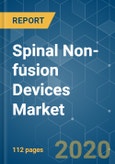The spinal non-fusion devices market is anticipated to exhibit a significant market growth during the forecast period, as a result of increasing incidences of spinal disorders, like degenerative disc disease. Degenerative disc disease begins with the changes in the intervertebral discs, but it also affects other segments.
According to the Arthritis Foundation, after the age of 40 years, a person may suffer from disc degeneration diseases. The other factors include the acceptance of minimally invasive surgeries, such as disc arthroscopy and advantages over spinal fusion surgeries. All these factors are boosting the market growth, over the forecast period.
Key Market Trends
Dynamic Stabilization Devices Segment Captured the Largest Market Share
The dynamic stabilization devices segment captured the largest market share in the market studied. These devices consist of pedicle screw-based systems, interspinous process spacers, and facet replacement products.
North America Dominated the Market Studied
North America holds the largest share of the market, owing to the significant growth factors, including increasing incidences of degenerative disc diseases, rising prevalence of geriatric population, rising government initiatives, and increased government product regulations with companies and hospitals.
Competitive Landscape
The major players of the spinal non-fusion devices market are Medtronic PLC, Stryker Corporation, Zimmer Holdings Inc., B Braun Melsungen, and Johnson & Johnson, among others. The increasing demand for spinal non-fusion devices, technological advancements, and rising innovations is expected to increase the overall competition among the market players. Hence, these market players are adopting strategies, such as mergers, acquisitions, and product innovations, to sustain the rising competition.
Reasons to Purchase this report:
According to the Arthritis Foundation, after the age of 40 years, a person may suffer from disc degeneration diseases. The other factors include the acceptance of minimally invasive surgeries, such as disc arthroscopy and advantages over spinal fusion surgeries. All these factors are boosting the market growth, over the forecast period.
Key Market Trends
Dynamic Stabilization Devices Segment Captured the Largest Market Share
The dynamic stabilization devices segment captured the largest market share in the market studied. These devices consist of pedicle screw-based systems, interspinous process spacers, and facet replacement products.
- The dominance of the segment can be attributed to the use of rigid spinal implants for fusion technologies. Additionally, the rising burden of spinal degenerative disorders plays a significant role in the segment's growth.
- Moreover, the technological advancements leading to change in the therapeutic procedures, such as biochemical improvements and adoption of BioFlex systems, are expected to propel the segment's growth.
- Lumbar disc herniation may lead to lower back pain and radicular leg pain. According to the Scoliosis and Spinal Disorders' journal in 2017, around 60% to 85% of the population experienced lower back pain. Non-fusion surgery can be used for the treatment of lumbar degenerative diseases. Hence, this factor is expected to fuel the dynamic stabilization devices segment in the market studied.
North America Dominated the Market Studied
North America holds the largest share of the market, owing to the significant growth factors, including increasing incidences of degenerative disc diseases, rising prevalence of geriatric population, rising government initiatives, and increased government product regulations with companies and hospitals.
- Recently, in 2020, Orthopediatrics Corporation acquired ApiFix Ltd, to include its FDA-approved non-fusion scoliosis technology.
- Europe also holds the second-largest market, as regulations governing the medical device sales are growing more stringent. Asia-Pacific, on the other hand, is expected to exhibit the fastest growth rate, over the forecast period.
Competitive Landscape
The major players of the spinal non-fusion devices market are Medtronic PLC, Stryker Corporation, Zimmer Holdings Inc., B Braun Melsungen, and Johnson & Johnson, among others. The increasing demand for spinal non-fusion devices, technological advancements, and rising innovations is expected to increase the overall competition among the market players. Hence, these market players are adopting strategies, such as mergers, acquisitions, and product innovations, to sustain the rising competition.
Reasons to Purchase this report:
- The market estimate (ME) sheet in Excel format
- 3 months of analyst support
Table of Contents
1 INTRODUCTION
4 MARKET DYNAMICS
5 MARKET SEGMENTATION
6 COMPETITIVE LANDSCAPE
Companies Mentioned (Partial List)
A selection of companies mentioned in this report includes, but is not limited to:
- B Braun Melsungen
- Centinel Spine LLC
- Johnson & Johnson
- Medtronic PLC
- Pioneer Surgical Technologies
- Stryker Corporation
- Zimmer Holdings Inc.
- RTI Surgical Holdings Inc.
- NuVasive Inc.
Methodology

LOADING...








